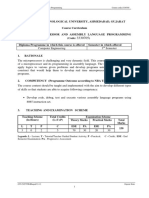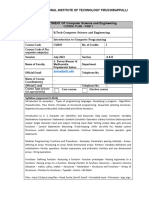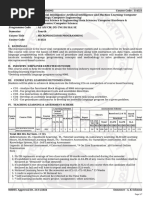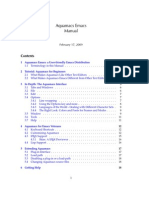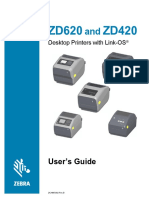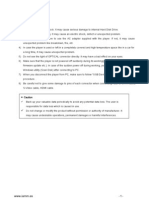Programming in C
Programming in C
Uploaded by
Aditya BhattacharayaCopyright:
Available Formats
Programming in C
Programming in C
Uploaded by
Aditya BhattacharayaOriginal Title
Copyright
Available Formats
Share this document
Did you find this document useful?
Is this content inappropriate?
Copyright:
Available Formats
Programming in C
Programming in C
Uploaded by
Aditya BhattacharayaCopyright:
Available Formats
Programming in C Course Code: 3331105
GUJARAT TECHNOLOGICAL UNIVERSITY, AHMEDABAD, GUJARAT
Course Curriculum
Course Title: PROGRAMMING IN C
(Code: 3331105)
Diploma Programme in which this course is Semester in which offered
offered
Electronics and Communication 3rd Semester
1. RATIONALE:
C forms the basics of C++, C#, Visual C/C++ etc which is current requirement in the
information technology (IT) and computer science (CS). It is one of the most commonly used
programming language in industry by engineers. It is a middle level language which combines
features of both the high level and low level language. It is widely used to develop system
programming, operating systems, embedded systems. Also, C is used for creating computer
applications that are used in writing embedded software/firmware for various micro-
controllers based products in electronics, industrial and communications. C is also used in
developing verification software, test code and simulators for various applications and
hardware products. It is therefore very important for electronic engineers to develop mastery
over C language.
2. COMPETENCY (Programme Outcome according to NBA Terminology):
The course should be taught and implemented with the aim to develop different types of
skills leading to the achievement of the following competencies:
Develop programs in C language.
3. TEACHING AND EXAMINATION SCHEME
Teaching Scheme Total Credits Examination Scheme
(In Hours) (L+T+P) Theory Marks Practical Marks Total
Marks
L T P C ESE PA ESE PA
200
3 0 4 7 70 30 40 60
Legends: L - Lecture; T - Tutorial/Teacher Guided Student Activity; P - Practical; C - Credit; ESE - End
Semester Examination; PA - Progressive Assessment
GTU/NITTTR/Bhopal/12-13 Gujarat State
1
Programming in C Course Code: 3331105
4. COURSE DETAILS
Major Learning Topics and Sub-topics
Outcomes (Course
Unit Outcomes in Cognitive
Domain according to NBA
terminology)
Unit – I 1a. Prepare flowcharts
1.1 Concepts of programming methodology.
Concepts , 1b. Develop algorithms
1.2 Flowchart
Constants, 1.3 Algorithm
Variables and 1c. Learns concept of 1.4 Character set
Data Types
constants and 1.5 'C' tokens
variables 1.6 Keywords & Identifiers
1.7 Constants
1.8 Variables, Declaration of variables
1.9 Assigning values to variables
1d. Distinguishes different 1.10 Data types
data types and storage 1.11 Storage Class, Declaration of storage
class 1.12 class
Unit – II 2a. Creates arithmetic and 2.1 Arithmetic operators
Operators logical programs 2.2 Relational operators
and 2.3 Logical operators
Expressions 2.4 Assignment operators
2.5 Increment and Decrement operators
2.6 Conditional operators
2.7 Bitwise operators and Special
Operators
2.8 Evaluation of arithmetic and logical
2.9 expressions
2b. Operates input and 2.10 Formatted input & output
output Functions 2.11 Unformatted input & output
2.12 I/O Functions: scanf(), printf(), getch(),
putch(), gets(),puts() Programming
exercises based on arithmetic and
logical expressions
Unit – III 3a. Develops decision 3.1 IF statement
Branching making sub routines 3.2 IF..else statement
and Looping 3.3 Nesting of if..Else statement
3.4 Else if ladder
3.5 Switch Statement
3.6 The? : Operator
3.7 Go To statement.
3.8 Programming based on decision making
3b. Implements looping in 3.9 While statement
programs 3.10 Do and Do while statement
3.11 For statement
3.12 Jumps in Loops
3.13 Use of break and continue statements in
looping
3.14 Complex programming exercises
GTU/NITTTR/Bhopal/12-13 Gujarat State
2
Programming in C Course Code: 3331105
Major Learning Topics and Sub-topics
Outcomes (Course
Unit Outcomes in Cognitive
Domain according to NBA
terminology)
Unit – IV 4a. Creates ability of 4.1 Introduction to Arrays and Strings
Arrays and handling large size 4.2 One dimensional arrays of int, float &
Pointers data of similar nature. characters
4.3 Initializing two dimensional arrays
4.4 Programming exercises based on One
dimensional arrays
4b. Understands efficient 4.5 Introduction to pointers
use of memory, access 4.6 Declaration and initialization of pointers
and distinguish real 4.7 Structure definition & initialization
world data types 4.8 Programming exercises based on Pointers
and structures
Unit – V 5a. Creates own functions 5.1 Introduction of User Defined functions
User Defined, and able to operate (UDF)
Library available library 5.2 Call by value & Call by reference
Functions functions 5.3 Library Functions: clrscr(), abs(), sqrt(),
and File og(), pow(), int(), isdigit(), isalpha(),
Management toupper(), tolower(), strlen(), strcat(),
strcpy, strcmp
5.4 Differences between library function &
5.5 UDF
5.6 Recursive function (Only Factorial
Example)
5.7 Programming exercises based on UDF
and library functions
5b. Develops ability to 5.8 Introduction of file management.
operate real world 5.9 Defining, Opening and Closing a file
projects 5.10 Input and Output Operations on files
5.11 Programming exercises based on file
management
GTU/NITTTR/Bhopal/12-13 Gujarat State
3
Programming in C Course Code: 3331105
5. SUGGESTED SPECIFICATION TABLE WITH HOURS & MARKS (THEORY)
Unit Unit Title Distribution of Theory Marks
Teaching R U A Total
Hours Level Level Level Marks
I Concepts, Constants, 8 3 5 6 14
variables and data types
II Operators and 9 2 4 10 16
expressions
III Branching and looping 12 4 6 10 20
IV Arrays, Pointers and 8 3 4 5 12
Structures
V User defined functions, 5 2 2 4 8
library functions and file
management
Total 42 14 21 35 70
Legends: R = Remember; U = Understand; A = Apply and above levels (Bloom’s revised taxonomy)
Note: This specification table shall be treated as a general guideline for students and teachers.
The actual distribution of marks in the question paper may vary slightly from above table.
6. SUGGESTED LIST OF EXERCISES/PRACTICAL
The practical/exercises should be properly designed and implemented with an attempt
to develop different types of practical skills (Course Outcomes in psychomotor and
affective domain) so that students are able to acquire the competencies (Programme
Outcomes). Following is the list of practical exercises for guidance.
Note: Here only Course Outcomes in psychomotor domain are listed as
practical/exercises. However, if these practical/exercises are completed appropriately,
they would also lead to development of Programme Outcomes/Course Outcomes in
affective domain as given in a common list at the beginning of curriculum document
for this programme. Faculty should refer to that common list and should ensure that
students also acquire those Programme Outcomes/Course Outcomes related to
affective domain.
Following is the list of Practical/exercise for guidance.
S. Unit Practical/Exercise (Course Outcomes in Psychomotor Domain Approx.
No. No. according to NBA Terminology) Hrs.
Required
1 I Use the software for editing compiling and running C programs. 2
2 I Use different menu options of software 2
3 I Initialize local variables 2
4 II Perform simple arithmetic using local variables 2
5 II Output data using printf and cout statement 2
6 II Input data using scanf and cin statements 2
GTU/NITTTR/Bhopal/12-13 Gujarat State
4
Programming in C Course Code: 3331105
S. Unit Practical/Exercise (Course Outcomes in Psychomotor Domain Approx.
No. No. according to NBA Terminology) Hrs.
Required
7 II Out put the data on screen using printf in required formats 2
8 II Use of various mathematical operators in C 2
9 II Perform floating point arithmetic programs 2
10 II Evaluate simple formula using C programs 2
11 II Develop & Test programs using Conditional or Logical 2
expressions
12 III Develop & Test programs with control structure like if , if-else 2
13 III Develop & Test programs with control structure like nested if- 2
else
14 III Develop & Test programs with else if ladder 2
15 III Develop & Test Programs with switch & break statement 2
16 III Develop & Test program with while loop 2
17 III Develop & Test program with do while loop 2
18 III Develop & Test program with for loop 2
19 III Develop & Test program using break and continue statements 2
20 IV Develop & Test programs to declare and initialize arrays 2
21 IV Develop & Test programs with one and two dimensional arrays 2
22 IV Develop & Test programs with character type arrays 2
23 IV Develop & Test programs to use library functions of C 2
24 IV Develop & Test programs related to pointer variables 2
25 IV Develop & Test programs related to structure variables 2
26 V Develop & Test programs with user defined functions 2
27 V Develop & Test programs to pass the value of local variables into 2
your C functions
28 V Create and read/write ASCII character file 2
Total 56
7. SUGGESTED LIST OF STUDENT ACTIVITIES
Following is the list of proposed student activities like:
1. Multiple choice questions, short questions and answers
2. Technical Quiz, seminar and debate
3. Rapid code development and debugging competition.
4. The course activities include: Formal Lecture: 30% Supervised Classroom Work:
5. 30% Supervised Laboratory Tutorials: 30% Unsupervised Directed Learning: 10%
8 SPECIAL INSRUCTIONAL STRETAGIES (If Any)
i. Concepts will be introduced in lectures using charts/ppt.
ii. Quiz on various topics
iii. Students should be helped in developing logic on individual basis (some sessions
may be as tutorials)
iv. Practical work will be through laboratory sessions.
GTU/NITTTR/Bhopal/12-13 Gujarat State
5
Programming in C Course Code: 3331105
9. SUGGESTED LEARNING RESOURCES
(A) List of Books:
S. Title of Books Author Publication
No.
1 Programming in C Balagurusamy, E (Fifth Edition) Tata McGraw-Hill,
New Delhi, 2012
2 Programming in C Gottfried Byron (Third Edition) Tata McGraw-Hill,
New Delhi, 2012
3 Introduction to C Reema Thareja (First Edition) Oxford University
Programming (With Press, 2012
CD ROM support)
4 Programming in C Ashok N Kamthane Pearson
(Second Edition)
5 Let Us C Kanetkar Yashvant BPB Publications,
(Twelfth Edition) 2012
6 Programming in C Kernighan Brian and Ritchie Prentice Hall of India
Dennis (Second Edition) Pvt. Ltd., New Delhi,
2012
B. List of Major Equipment/Materials
i. Computers with C and C++ language programming facilities. (Separate
computer for each student)
ii. Multimedia projector, Tutorial Video CD (Programming in C), Expert video
lectures.
C List of Software/Learning Websites
i. Software/tools : Turbo C or Borland C, Visual Studio
ii. Theory and programming concepts: www.nptel.iitm.ac.in
iii. www.nptelvideos.com/programming/c_programming_videos.php
iv. www.ocw.mit.edu (Practical Programming in C - MIT Open Course Ware)
v. www.cprogramming.com
vi. http://www2.its.strath.ac.uk/courses/c/
vii. http://www.iu.hio.no/~mark/CTutorial/C-Tut-4.02.pdf
GTU/NITTTR/Bhopal/12-13 Gujarat State
6
Programming in C Course Code: 3331105
10. COURSE CURRICULUM DEVELOPMENT COMMITTEE
Faculty Members from Polytechnics
Prof. S. N. Sampat, Sr. Lecturer, Government Polytechnic, Gandhinagar
Prof. G.V. Parmar, Lecturer, Government Polytechnic, Jamnagar
Prof. R. B. Shah, Sr. Lecturer, Government Polytechnic, Ahmedabad.
Prof. (Smt.) P. G. Patel, Lecturer, Government Polytechnic, Ahmedabad.
Coordinator and Faculty Members from NITTTR Bhopal
Dr. Shailendra Singh, Professor & Head Dept. of Computer Engineering and
Applications
Dr. Priyanka Tripathi, Associate Professor, Dept. of Computer Engineering and
Applications
GTU/NITTTR/Bhopal/12-13 Gujarat State
7
You might also like
- EE1005 From Computational Thinking To Programming - OBTLDocument5 pagesEE1005 From Computational Thinking To Programming - OBTLAaron TanNo ratings yet
- 3350703Document8 pages3350703MayurNo ratings yet
- Advanced Database Management System Course Code: 3340701Document5 pagesAdvanced Database Management System Course Code: 3340701Madhav KotechaNo ratings yet
- Microprocessor and Assembly Language Programming Course Code:3330705Document5 pagesMicroprocessor and Assembly Language Programming Course Code:3330705હિરેનપ્રફુલચંદ્રજોષીNo ratings yet
- Computer Organisation and ArchitectureDocument5 pagesComputer Organisation and ArchitectureHarshil GajjarNo ratings yet
- Obe Curriculum For The Course: RGPV (Diploma Wing) BhopalDocument22 pagesObe Curriculum For The Course: RGPV (Diploma Wing) Bhopalकिशोरी जूNo ratings yet
- 1st Sem Syllabus (ICT 416 Programming Concept With C)Document5 pages1st Sem Syllabus (ICT 416 Programming Concept With C)kamalshrishNo ratings yet
- Course OutlineDocument6 pagesCourse OutlineChaman Ali AfzaliNo ratings yet
- ProgrammingDocument5 pagesProgrammingodib478No ratings yet
- Amanuel CourseoutlineDocument2 pagesAmanuel CourseoutlinemerihuNo ratings yet
- CP SyllabusDocument5 pagesCP SyllabusAqsa KhanNo ratings yet
- MALPDocument5 pagesMALPjainamshahNo ratings yet
- BCA SyllabusDocument21 pagesBCA Syllabusjayapadmanabhan263No ratings yet
- Grade - 9 Computer Engineering - C-ProgrammingDocument77 pagesGrade - 9 Computer Engineering - C-ProgrammingArpan sapkotaNo ratings yet
- Course Plan Microprocessor and Assembly LLDocument3 pagesCourse Plan Microprocessor and Assembly LLGcross NGNo ratings yet
- Computer Programing PDFDocument3 pagesComputer Programing PDFEthio Video SchoolNo ratings yet
- Secondary Level School Curriculum: (Technical and Vocational Stream)Document321 pagesSecondary Level School Curriculum: (Technical and Vocational Stream)kumarishu1423No ratings yet
- Data Structure PDFDocument7 pagesData Structure PDFJainil Kishorbhai DalwadiNo ratings yet
- Database Administration: Course Code: 3361605Document6 pagesDatabase Administration: Course Code: 3361605KanhaNo ratings yet
- Advanced Java Programming Course OutlineDocument4 pagesAdvanced Java Programming Course Outlineeyobeshete16No ratings yet
- Course Plan Microprocessor and Assembly LDocument3 pagesCourse Plan Microprocessor and Assembly LGcross NGNo ratings yet
- ADP (Computing) 1st Programming Fundamental OutlineDocument7 pagesADP (Computing) 1st Programming Fundamental Outlineseekingcharm2006No ratings yet
- C PrograamingDocument76 pagesC PrograamingPawanNo ratings yet
- PF OutlineDocument5 pagesPF Outlineikram09293No ratings yet
- 3.1 Programming in C L T P 4 - 6 RationaleDocument20 pages3.1 Programming in C L T P 4 - 6 Rationalevishu sharmaNo ratings yet
- 02introduction To Programming Edip Senyureksyllabus20232024Document3 pages02introduction To Programming Edip Senyureksyllabus20232024princessoke141No ratings yet
- FSD PDFDocument5 pagesFSD PDFJainil Kishorbhai DalwadiNo ratings yet
- IT112Document5 pagesIT112jeriko pelimianoNo ratings yet
- Sophia Introduction To Python Programming SyllabusDocument5 pagesSophia Introduction To Python Programming SyllabusAdnan HussainNo ratings yet
- Kyu/F/Asa/02 School of Pure and Applied Sciences Department of Pure and Applied SciencesDocument4 pagesKyu/F/Asa/02 School of Pure and Applied Sciences Department of Pure and Applied Sciencestoo robaaNo ratings yet
- 3320702Document5 pages3320702glennfreyola0% (1)
- 0-CC1021 Programming Fundamentals Outline-V1 (Revised)Document6 pages0-CC1021 Programming Fundamentals Outline-V1 (Revised)bilalashiq190No ratings yet
- Programming Fundamentals BSCS+BSSE-I Health Sciences Wing 2021 (1)Document4 pagesProgramming Fundamentals BSCS+BSSE-I Health Sciences Wing 2021 (1)abdullahsnap1919No ratings yet
- Operating Systems Course Code: 3330701Document6 pagesOperating Systems Course Code: 3330701Monil SolankiNo ratings yet
- 09ce1104pdf 2020 01 01 10 52 27Document5 pages09ce1104pdf 2020 01 01 10 52 27asgamingNo ratings yet
- CS F111 Computer Programming I Sem 2022-2023 HODocument5 pagesCS F111 Computer Programming I Sem 2022-2023 HOjohn doeNo ratings yet
- Engineering Mathematics I: Tutorial: Practical: Course Objectives: YearDocument27 pagesEngineering Mathematics I: Tutorial: Practical: Course Objectives: YearPappu ThakurNo ratings yet
- PF Course OutlineDocument7 pagesPF Course Outlinewaseem khosaNo ratings yet
- AI_ML_ReportDocument24 pagesAI_ML_Reportutkarshp177No ratings yet
- Course Code Course Name Teaching Scheme (Contact Hours) Credits Assigned Theory Pract. Tut. Theory Tut. Pract. TotalDocument3 pagesCourse Code Course Name Teaching Scheme (Contact Hours) Credits Assigned Theory Pract. Tut. Theory Tut. Pract. TotalanniisaniketNo ratings yet
- COSC1046 - Course OutlineDocument6 pagesCOSC1046 - Course OutlineYashkaran 001No ratings yet
- 3340704Document7 pages3340704sanket shahNo ratings yet
- University of Sialkot: Faculty of Computing & Information Technology Department of Computer ScienceDocument3 pagesUniversity of Sialkot: Faculty of Computing & Information Technology Department of Computer ScienceZain IkramNo ratings yet
- Advanced Programming Java - Course Outline ITDocument3 pagesAdvanced Programming Java - Course Outline ITኢየሩሳሌም ገብረ ክርስቶስNo ratings yet
- CSIR11-Introduction-to-Computer-ProgrammingDocument6 pagesCSIR11-Introduction-to-Computer-ProgrammingmejuliajNo ratings yet
- Computer ProgrammingDocument4 pagesComputer Programmingvipar snikeNo ratings yet
- DTE Micrproject FormatDocument6 pagesDTE Micrproject FormatGaurav LanghiNo ratings yet
- Faculty of Engineering & Technology: Ganpat UniversityDocument3 pagesFaculty of Engineering & Technology: Ganpat UniversityBLACK彡PANDAA GamingNo ratings yet
- Jimma University Course OutlineDocument1 pageJimma University Course OutlineCHARA100% (1)
- List of Practicals BS CS (Revised)Document23 pagesList of Practicals BS CS (Revised)Maham EhtishamNo ratings yet
- 1-1 Lab Manual - Programming FundamentalsDocument147 pages1-1 Lab Manual - Programming Fundamentalstayyabaliaqat373No ratings yet
- PBLJ Syllabus HybridDocument6 pagesPBLJ Syllabus HybridkazefiledownloaderNo ratings yet
- 6th Sem SyllabusDocument19 pages6th Sem SyllabusshravNo ratings yet
- Comp 2Document6 pagesComp 2jeriko pelimianoNo ratings yet
- 314321-MICROPROCESSOR PROGRAMMINGDocument7 pages314321-MICROPROCESSOR PROGRAMMINGkhaparderahilNo ratings yet
- CoursePlanner 212Document3 pagesCoursePlanner 212weimin chooNo ratings yet
- WIT-Course Material-Unit-3Document82 pagesWIT-Course Material-Unit-3PraneethNo ratings yet
- sophia-introduction-to-python-programming-syllabusDocument5 pagessophia-introduction-to-python-programming-syllabusAhmad ReshadNo ratings yet
- Rainbow Usage Guide: Data Connection EstablishmentDocument13 pagesRainbow Usage Guide: Data Connection EstablishmentPedroNo ratings yet
- DEBEG 4610 Navigation EchosounderDocument4 pagesDEBEG 4610 Navigation EchosounderСерёжа НоурNo ratings yet
- TPEditor V1.10 ManualDocument100 pagesTPEditor V1.10 ManualNarendra BholeNo ratings yet
- Ds4windows LogDocument1 pageDs4windows LogMonfoNo ratings yet
- Procedural Statements and Flow ControlDocument16 pagesProcedural Statements and Flow ControlTaha PerwaizNo ratings yet
- 0576.MSP430 Programming Via The Bootstrap LoaderDocument52 pages0576.MSP430 Programming Via The Bootstrap LoaderBiplab RoyNo ratings yet
- Cisco 2901 Integrated Services Router W/ 2x Gigabit, 4x EHWIC Slots, 2x DSP Slots & 1x ISM Slot - CISCO2901/K9Document6 pagesCisco 2901 Integrated Services Router W/ 2x Gigabit, 4x EHWIC Slots, 2x DSP Slots & 1x ISM Slot - CISCO2901/K9tuan_fet2005No ratings yet
- PROG102 GCS210085 LeThaiTrungTin Assignment 1 Full (AutoRecovered)Document31 pagesPROG102 GCS210085 LeThaiTrungTin Assignment 1 Full (AutoRecovered)Le Thai Trung Tin (FGW HCM)No ratings yet
- Adding Button in Classical Report - SAP CommunityDocument7 pagesAdding Button in Classical Report - SAP Communitygerman martinezNo ratings yet
- Aquamacs ManualDocument58 pagesAquamacs Manualrobson_bassNo ratings yet
- Codsoft InternshipDocument7 pagesCodsoft Internshipharry128223No ratings yet
- CP Assignment Moores LawDocument6 pagesCP Assignment Moores LawbilalNo ratings yet
- Dbms Question Bank AnsDocument16 pagesDbms Question Bank AnsHarish KhopeNo ratings yet
- 2022 CSCI1130-Tutorial03 Boolean and OperatorsDocument44 pages2022 CSCI1130-Tutorial03 Boolean and OperatorsTszkin WongNo ratings yet
- Zebra ZD420 ZD620 Full PDFDocument348 pagesZebra ZD420 ZD620 Full PDFHeathNo ratings yet
- COMELEC-PCOS Training PresentationDocument111 pagesCOMELEC-PCOS Training PresentationIwai MotoNo ratings yet
- Brochure Ricoh Imc 300Document4 pagesBrochure Ricoh Imc 300Estrella LunaNo ratings yet
- Final Theory Exam Practice QuestionsDocument2 pagesFinal Theory Exam Practice Questionspgking27No ratings yet
- Fasttrack, Fastpath, Isp Network DesignDocument68 pagesFasttrack, Fastpath, Isp Network DesignIwan YuliantoNo ratings yet
- DevOps Interview QuestionSDocument10 pagesDevOps Interview QuestionSsreenu777No ratings yet
- Manual Honeywell Pm42Document111 pagesManual Honeywell Pm42Claudio Albino CensiNo ratings yet
- DM74LS194A 4-Bit Bidirectional Universal Shift RegisterDocument6 pagesDM74LS194A 4-Bit Bidirectional Universal Shift Registerhayssam100% (1)
- BPM Composer ErrorDocument33 pagesBPM Composer Errorlarenge2001No ratings yet
- 5.3.1.10 Lab - Using IOS CLI With Switch MAC Address TablesDocument5 pages5.3.1.10 Lab - Using IOS CLI With Switch MAC Address TablesThomas RamosNo ratings yet
- Control Flow CheatsheetDocument4 pagesControl Flow CheatsheetPranay BagdeNo ratings yet
- Manual Ntd29 enDocument20 pagesManual Ntd29 enCucu MotNo ratings yet
- Digital Logic MCQ - Digital Logic Questions Answers - Avatto-Page6Document2 pagesDigital Logic MCQ - Digital Logic Questions Answers - Avatto-Page6Kuldeep KushwahaNo ratings yet
- iFIX Database WhitepaperDocument6 pagesiFIX Database WhitepaperjavierleraNo ratings yet
- Introduction To HMCDocument22 pagesIntroduction To HMChimansusekharNo ratings yet
- Chapter 5 - Windows Programming in C#Document45 pagesChapter 5 - Windows Programming in C#dagneNo ratings yet



